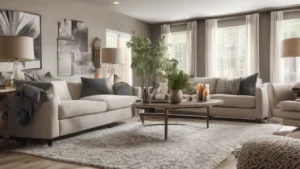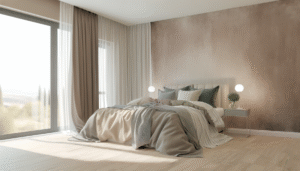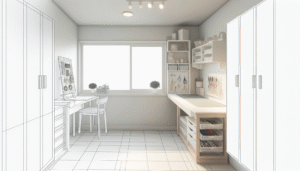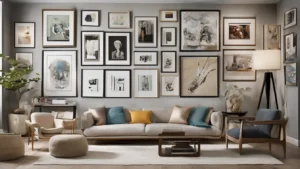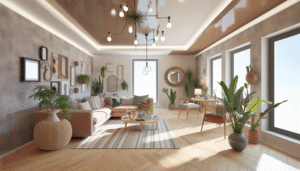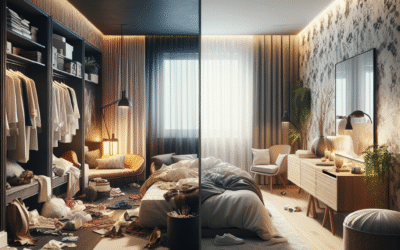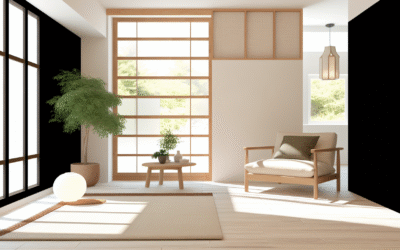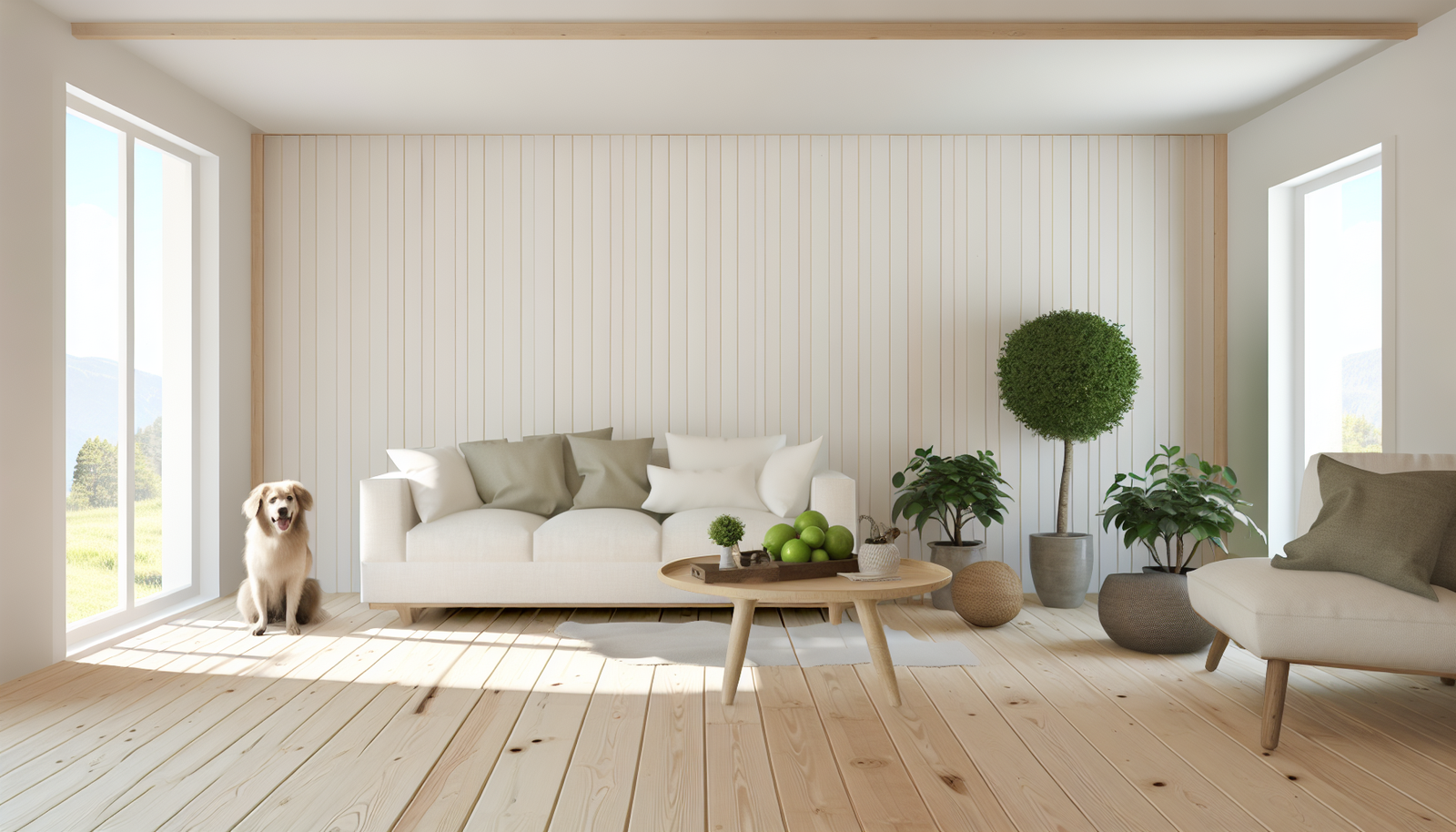
Are you juggling between your love for a serene, uncluttered home and the boundless joy (and occasional chaos) brought by your beloved pets? It’s a common dilemma. Many homeowners find themselves sacrificing interior design aspirations for the sake of practicality when pet owners are not considering design.
But what if you didn’t have to choose? What if you could blend the serene simplicity of Japanese design with the cozy functionality of Scandinavian style, creating truly harmonious Japandi minimalist pet-friendly spaces? Imagine a home where every element serves a purpose, brings beauty, and coexists peacefully with your furry companions. A space that not only looks stunning but also stands up to playful paws, shedding seasons, and muddy adventures.
In this comprehensive guide, we’ll dive deep into the philosophy and practical applications of Japandi design, specifically tailored to accommodate pets seamlessly. You’ll learn how to select durable materials, integrate functional furniture, optimize layouts for both human and animal comfort, and maintain a pristine, calming atmosphere without compromising your pet’s happiness. This article promises to transform your living environment into a sanctuary that celebrates both sophisticated design and unconditional pet love.
We’ll cover everything from the foundational principles of Japandi and pet-friendly elements, to selecting the right materials, designing purposeful layouts, and maintaining an effortlessly stylish home. Prepare to unlock the secrets to a home that is both a visual delight and a haven for your cherished companions.
Understanding the Japandi Aesthetic in Pet-Friendly Design
The convergence of Japanese ‘wabi-sabi’ (finding beauty in imperfection) and Scandinavian ‘hygge’ (coziness and comfort) gives birth to Japandi. This design philosophy prizes natural materials, clean lines, muted color palettes, and functional simplicity. When translated into Japandi minimalist pet-friendly spaces, these principles become incredibly powerful, creating environments that are both aesthetically pleasing and resilient enough to handle pet life.
The Core Principles of Japandi Style
- Simplicity & Minimalism: Decluttering is key. Every item should have a purpose or bring joy. This directly benefits pet owners by reducing potential hazards and making cleaning easier. Fewer items mean fewer things to knock over or chew!
- Natural Materials: Wood, bamboo, rattan, linen, cotton, and ceramics are hallmarks. These materials often feature natural textures and organic tones, which are forgiving to pet wear and tear and are generally safer for pets.
- Neutral Color Palette: Whites, grays, beiges, and soft earth tones dominate. These colors are not only calming but also surprisingly practical for hiding minor pet smudges or fur.
- Functionality & Durability: Objects are chosen for their utility and longevity. This aligns perfectly with the need for robust furniture and surfaces in a pet household.
- Craftsmanship & Quality: Investing in well-made items that last. This reduces waste and means less frequent replacement, even with pets around.
- Connection to Nature: Incorporating indoor plants (pet-safe ones!), natural light, and an overall sense of tranquility.
Why Japandi Is Inherently Pet-Friendly
At its heart, Japandi design champions sustainability and quality. These are values that inadvertently benefit pet owners. Think about it: a durable sofa in a neutral tone, made of high-quality, rip-resistant fabric, is inherently more pet-friendly than a delicate, brightly colored one. The emphasis on clean lines and uncluttered spaces means fewer dust bunnies (and pet hair tumbleweeds) accumulating in hidden corners, and significantly easier cleaning routines. Furthermore, the extensive use of natural materials often translates to non-toxic environments, which is a major consideration for pets who explore with their mouths and paws.
Laying the Foundation: Materials & Furnishings for Pet-Friendly Japandi
The choice of materials is paramount in creating successful Japandi minimalist pet-friendly spaces. Durability, ease of cleaning, and pet safety should be top priorities.
Flooring That Stays Flawless (Mostly)
When pets are part of the family, your flooring takes a beating. Scratches, spills, and shedding are inevitable. Japandi’s preference for natural, durable surfaces makes selection simpler:
- Hardwood (Sealed): Oak, bamboo, or even reclaimed wood. Ensure it’s properly sealed to prevent moisture absorption from accidents. Lighter wood tones can minimize the appearance of scratches. Opt for a matte finish to further conceal minor imperfections.
- Laminate & Vinyl Plank: Excellent alternatives for scratch and water resistance. Modern laminates can mimic natural wood incredibly well and are budget-friendly. Vinyl is virtually waterproof and very easy to clean.
- Concrete (Polished): A highly durable, industrial-chic option that fits the minimalist aesthetic. It’s cool, easy to clean, and virtually indestructible. Consider rugs for added warmth and grip for older pets.
- Tile: Porcelain or ceramic tiles are incredibly resistant to scratches and moisture. Choose matte finishes to avoid slipperiness for pets and to hide dirt.
Avoid: High-pile carpets (attracts fur, difficult to clean), unsealed natural stone (porous), easily scratched softwoods.

Furniture Selection: Style Meets Stamina
Your furniture needs to withstand daily use by both humans and animals. Japandi’s emphasis on quality over quantity serves as a guiding light.
- Solid Wood Pieces: Tables, shelving, and bed frames made from oak, ash, or walnut are incredibly robust. Their natural grains also disguise minor nicks better than painted surfaces.
- Upholstery Fabrics:
- Performance Fabrics: Look for materials labelled “performance” or “pet-friendly.” These often include microfibers, synthetic blends, or tightly woven natural fabrics that resist stains, odors, and snagging. Crypton, Sunbrella, and other outdoor-grade fabrics are excellent indoor choices for their resilience.
- Leather/Vegan Leather: Surprisingly pet-friendly! Hair doesn’t cling, and spills wipe up easily. Minor scratches can add to its character.
- Canvas/Sailcloth: Durable and washable, perfect for slipcovers.
- Wool Blends: Naturally stain-resistant and durable, but some blends can attract pet hair.
- Elevated Furniture: Sofas and chairs with legs allow for easy cleaning underneath and prevent pets from hiding or hoarding toys/hair beneath them.
- Integrated Storage: Pieces with built-in storage help maintain the minimalist, clutter-free look, providing discreet places for pet toys, leashes, and grooming supplies.
Tip: Consider furniture that can be easily cleaned. Slipcovers are a lifesaver for pet owners and perfectly align with the relaxed Japandi vibe. For pet beds, choose washable covers and supportive inserts.
Choosing the Right Rugs & Textiles
Rugs add warmth, define spaces, and provide comfort underfoot for both people and pets. They also reduce echoes and protect floors.
- Low-Pile & Flatweave Rugs: Easier to vacuum and less prone to snagged claws. Wool, jute, sisal, or synthetic blends (like polypropylene) are ideal.
- Washable Rugs: Ruggable and similar brands offer rugs that can be thrown directly into a large washing machine, a game-changer for pet accidents.
- Neutrals & Patterns: Darker neutrals or subtle patterns can help camouflage pet hair and minor stains between cleanings.
For throws and blankets: Choose machine-washable cotton, linen, or fleece in neutral tones. These can provide a designated cozy spot for your pet on furniture, protecting the upholstery. Don’t forget pet-specific blankets and towels for paws after walks!
Designing for Coexistence: Layout & Organization in Japandi Spaces
A truly pet-friendly Japandi home isn’t just about aesthetics; it’s about thoughtful design that caters to the needs of every inhabitant. Smart layouts and diligent organization are crucial for maintaining the minimalist look and ensuring harmony.
Optimizing Layout for Flow & Safety
The Japandi principle of open, flowing spaces naturally benefits pets, offering them more room to move. However, careful consideration is needed to ensure safety and prevent common pet-related issues:
- Clear Pathways: Ensure furniture placement allows for wide, unobstructed paths. This prevents pets from knocking things over or getting caught.
- Designated Pet Zones: Create specific areas for your pet’s needs. A feeding station, a cozy bed nook, or a play area. This helps keep pet supplies contained and reinforces good habits.
- Vertical Storage & Wall-Mounted Shelves: Utilize vertical space to keep delicate items, toxic plants, or important papers out of paw’s reach. Floating shelves align perfectly with minimalist design.
- Avoid Clutter Hotspots: Identify areas prone to clutter (e.g., entranceways, coffee tables) and implement conscious strategies to keep them clear. Baskets and hidden storage are your friends.
- Secure Loose Wires & Cords: Ensure all electrical cords are tucked away, ideally using cord covers or furniture with built-in cable management. This is critical for pet safety, especially for puppies and kittens.
- Ease of Access to Outdoors: If you have a pet door, ensure it’s well-integrated into the design and provides a smooth transition to a secure outdoor space.
Consider a dedicated “mudroom” or entry zone, even a small corner, with hooks for leashes, a washable mat, and storage for paw-wiping towels. This helps contain dirt before it spreads through your pristine Japandi home.
Integrating Pet Furniture Seamlessly
Pet furniture doesn’t have to be an eyesore. With Japandi, it can actually enhance the aesthetic.
- Hidden Pet Beds: Consider beds that slide under a console table, integrate into a custom cabinet, or are designed to look like a stylish pouf or bench.
- Designer Bowls & Feeders: Ditch brightly colored plastic. Opt for ceramic, stoneware, or stainless steel bowls in neutral colors. Elevated feeders made of wood can also blend beautifully.
- Scratching Posts & Trees: Look for posts covered in natural fibers like sisal or jute. Some modern cat trees are designed with minimalist aesthetics, using wood and neutral fabrics, blending into a Japandi interior much better than traditional carpeted options.
- Built-in Solutions: Custom cabinetry can incorporate pet crates, feeding stations, or even litter box enclosures, keeping them out of sight and neatly integrated.

The Art of Pet-Proofing with a Japandi Lens
Pet-proofing goes beyond just safety; it’s about preserving the minimalist aesthetic. A well-pet-proofed home is a less stressful home for both you and your animals.
Pet-Proofing Checklist for Your Japandi Home:
- Toxic Plants: Research and remove all plants toxic to pets. Replace with pet-safe options like Boston ferns, money trees, or spider plants, displayed in simple ceramic pots.
- Breakables & Valuables: Store delicate vases, ceramics, and ornaments in enclosed cabinets or on high shelves. Fewer decorative items are better in Japandi.
- Trash Cans: Use pedal-activated or lidded trash cans to prevent curious paws from rummaging.
- Cleaning Products: Store all household cleaners in secure, inaccessible cabinets.
- Window Coverings: Opt for cordless blinds or shutters. Dangling cords can be a strangulation hazard for pets.
- Gate Integration: If you use pet gates, choose ones with clean lines and natural wood or metal finishes that complement your Japandi aesthetic, rather than brightly colored plastic.
By proactively addressing these points, you create a beautiful, safe, and easily maintainable environment that truly celebrates Japandi minimalist pet-friendly spaces.
A Touch of Nature: Pet-Safe Biophilic Design
Connecting with nature is a cornerstone of both Japanese and Scandinavian design. Integrating natural elements, known as biophilic design, not only enhances well-being but can also enrich your pet’s environment. The key is to do it safely and thoughtfully, especially in Japandi minimalist pet-friendly spaces.
Pet-Safe Plants & Greenery
Bringing greenery indoors adds life, purifies air, and complements the natural materials of Japandi. However, many common houseplants are toxic to pets. Always double-check before introducing new plants.
Pet-Friendly Plant Recommendations:
- Spider Plant (Chlorophytum comosum): Easy to care for, air-purifying, and completely safe for cats and dogs.
- Boston Fern (Nephrolepis exaltata): Lush green foliage, ideal for hanging baskets or high shelves. Non-toxic.
- Parlor Palm (Chamaedorea elegans): A striking, low-maintenance palm that adds a tropical touch, safe for pets.
- Money Tree (Pachira aquatica): Known for good luck, these are non-toxic and have a sculptural quality.
- Haworthia (Haworthia zebra): A small succulent with architectural appeal, safe for pets.
- Cat Grass/Wheatgrass: Specifically grown for cats, aiding digestion and reducing hairballs. Makes a great snack!
Plants to Avoid (Commonly Toxic): Lilies, Sago Palm, Peace Lilies, Pothos, Philodendrons, Dieffenbachia, Azaleas, Tulips, Daffodils, Oleander, Cyclamen, Kalanchoe.
Display plants in simple ceramic, terracotta, or woven baskets that align with the Japandi aesthetic. Elevate plants on stands or hang them to keep them out of direct reach of curious chewers while still enjoying their beauty.
Natural Light: Harnessing its Power
Japandi design maximizes natural light to create bright, airy, and expansive feelings. This also benefits pets, especially those who enjoy basking in sunbeams.
- Unobstructed Windows: Use minimal window treatments. Sheer linen curtains or simple, cordless bamboo blinds allow light to filter in while maintaining privacy.
- Strategic Furniture Placement: Avoid blocking windows with large furniture. Allow natural light to flood the space.
- Reflective Surfaces: While Japandi favors matte, the judicious placement of a mirror can amplify natural light, provided it’s securely mounted and not a hazard.
Natural light contributes to a calming environment, reducing the need for artificial lighting during the day and impacting mood positively for both humans and animals.
Incorporating Organic Textures & Elements
Beyond plants, other natural elements reinforce the Japandi connection to nature and create a stimulating environment for pets:
- Wood Accents: Untreated or minimally treated wood bowls, decorative branches (free from pests and toxins), or driftwood pieces (too large to be swallowed).
- Stone & Ceramic: Smooth river stones (large enough not to be a choking hazard) as decorative accents. Hand-thrown ceramic bowls or art pieces.
- Natural Fiber Textiles: Wool, linen, cotton, jute, and hemp rugs, blankets, and cushions not only add texture but are often more durable and easier to clean than synthetic alternatives.
- Water Features: A small, quiet indoor water feature can add a serene sound element, but ensure it’s pet-safe (no small, easily ingested parts) and water quality is maintained.
These elements create a sensory-rich environment for pets, tapping into their instincts and promoting a more enriched living experience within your elegant Japandi minimalist pet-friendly spaces.
Maintaining Serenity: Cleaning & Organization Strategies
A minimalist space with pets needs a smart approach to cleanliness. The Japandi aesthetic thrives on order and calm, which can seem challenging with furry companions. However, with the right strategies, maintaining your pristine Japandi minimalist pet-friendly spaces is entirely achievable.
Daily Rituals for a Cleaner Home
Prevention is always better than cure. Incorporating a few quick habits can drastically reduce the accumulation of pet hair, dirt, and odors.
- Daily Brushing: Regularly brush your pet, especially shedding breeds. Do it outdoors or over an easy-to-clean surface to contain the hair.
- Quick Vacuum/Sweep: A daily quick pass with a lightweight, pet-specific vacuum or broom in high-traffic areas keeps fur and dirt at bay. Robotic vacuums are a game-changer here, maintaining floors automatically.
- Wipe Down Paws: Keep a designated towel or paw cleaner at the door to wipe muddy paws before your pet enters the main living areas.
- Spot Clean Immediately: Address spills and accidents promptly to prevent stains and odors from setting into floors or fabrics.
- Designated Pet Mats: Place washable mats under feeding bowls and designated resting spots to catch spills and shed fur.
Deep Cleaning & Odor Control
Beyond daily maintenance, periodic deep cleaning ensures your home remains fresh and odor-free.
- Wash Pet Bedding Regularly: Pet beds, blankets, and throws should be washed weekly or bi-weekly according to manufacturer instructions.
- Upholstery Cleaning: Depending on the fabric, vacuum upholstered furniture frequently with a pet attachment. Consider professional cleaning for deeper issues, or use a portable spot cleaner for immediate spills.
- Air Purifiers: A high-quality air purifier with a HEPA filter can significantly reduce pet dander, odors, and airborne allergens, contributing to a fresher atmosphere.
- Natural Odor Absorbers: Use bowls of baking soda, activated charcoal, or white vinegar in discreet locations to naturally absorb odors. Essential oil diffusers (using pet-safe oils like lavender or frankincense, away from direct pet exposure) can also refresh the air.
- Enzyme Cleaners: For urine accidents, enzyme-based cleaners are essential as they break down the odor-causing bacteria, preventing pets from returning to the same spot.
Remember: Proper ventilation is crucial. Open windows regularly to air out your home and reduce stagnant odors.
Smart Storage and Decluttering for Pet Owners
The core of minimalism is an uncluttered space. With pets, this means intentional organization for their myriad accouterments.
- Baskets & Bins: Woven baskets (seagrass, rattan) or minimalist wooden bins are perfect for stashing toys, grooming tools, and extra leashes. Keep them within reach but organized.
- Closed Storage: Cabinets, drawers, and console tables with doors are invaluable for hiding unsightly items like bulk pet food, supplements, or cleaning supplies.
- Wall-Mounted Solutions: Floating shelves for pet-safe plants or decor, and wall hooks for leashes and harnesses, keep floors clear and reinforce the minimalist aesthetic.
- Pet Food Dispensers: Consider elegant, airtight pet food containers that double as decor or fit neatly into custom cabinets.
By implementing these cleaning and organization strategies, your Japandi minimalist pet-friendly spaces will not only look impeccably clean but also feel wonderfully fresh and serene, living up to the promise of harmonious coexistence.
Case Studies & Inspiration: Bringing Japandi Pet-Friendly to Life
Seeing how others have successfully blended Japandi minimalism with pet-friendly solutions can be incredibly insightful. These examples demonstrate the practical application of the principles discussed, showing how diverse pets can thrive in beautifully designed homes.
Case Study 1: The Urban Apartment Dweller with a Cat
The Challenge: A compact city apartment, home to a design-conscious professional and her energetic cat. Maximizing space and preventing the cat from damaging furniture were key concerns.
Japandi Solution:
- Vertical Play: Custom-designed, floor-to-ceiling cat shelf system made from light-colored wood and sisal rope. It doubles as a sculptural art piece and a stimulating climbing structure, keeping the cat entertained and off furniture.
- Integrated Litter Box: A stylish, minimalist cabinet in natural wood houses the litter box, vented to the outside, eliminating odors and keeping it out of sight.
- Durable Upholstery: Sofa and chairs covered in a tightly woven, pet-friendly performance fabric in a neutral grey, impervious to snags.
- Plant Protection: Pet-safe spider plants hung in ceramic planters from the ceiling, adding greenery without being accessible.
- Minimalist Furniture: A simple, solid oak coffee table and media console. No inviting surfaces for chewing or scratching.
Outcome: A serene, uncluttered urban sanctuary that the cat navigates with ease, offering ample play opportunities without compromising the minimalist aesthetic. The owner reports a calm environment and easy cleaning, perfect for Japandi minimalist pet-friendly spaces.

Case Study 2: The Suburban Family Home with Two Dogs
The Challenge: A bustling family home with two large, active dogs. The owners wanted a cohesive design that could withstand heavy pet traffic, shedding, and occasional muddy paws, while maintaining a calming Japandi vibe.
Japandi Solution:
- Resilient Flooring: Large format porcelain tiles (matte finish) throughout the main living areas, paired with durable, engineered oak in bedrooms. Easy to clean and scratch-resistant.
- Washable Rugs: High-traffic zones feature large, washable low-pile rugs in a subtle pattern, providing comfort for dogs and protecting floors further.
- Built-in Dog Bed Area: A custom-built-in bench near a sunny window serves as a cozy dog bed area, complete with washable covers and built-in storage for toys and leashes.
- Performance Fabrics: Sofa upholstered in a dark, stain-resistant micro-suede. Individual cushions are removable and washable.
- Outdoor Access Zone: A dedicated entry from the backyard with durable tile, a sink for paw washing, and hooks for leashes/towels – a true Japandi-inspired “mudroom.”
Outcome: A beautiful, functional home where the dogs are fully integrated into the family life without the house succumbing to pet chaos. The owners enjoy a consistent aesthetic and practical solutions for managing two large dogs, proving the durability and beauty of Japandi minimalist pet-friendly spaces.

Inspiring Resources & Products
- Pet-Friendly Furniture Brands: Many high-end and mid-range furniture retailers now offer pet-friendly fabric options. Brands like Joybird, Article, and even custom upholsterers are good starting points.
- Minimalist Pet Accessories: Check out designers like MiaCara, Fable Pets, or Japanese brands for stylish, durable bowls, beds, and toys that fit the Japandi aesthetic.
- Smart Home Pet Tech: Automatic feeders, water fountains (stainless steel or ceramic), and self-cleaning litter boxes can simplify pet care while blending into a minimalist environment. (e.g., Lomi, Litter-Robot).
- Sustainable Materials Suppliers: For DIY projects or custom furniture, source from companies specializing in sustainably harvested wood, VOC-free finishes, and natural textiles.
These examples and resources underscore that creating stunning Japandi minimalist pet-friendly spaces is not just a dream, but a highly attainable reality through thoughtful choices and intentional design.
Advanced Considerations for the Pet-Centric Japandi Home
Beyond the basics, there are advanced techniques and considerations that elevate Japandi minimalist pet-friendly spaces from merely functional to truly exceptional. These delve into sensory design, sustainable living, and future-proofing your home.
Sensory Design for Pets & Humans
A truly harmonious space considers all senses, not just sight. Japandi’s emphasis on tranquility extends to how a home feels, sounds, and smells.
- Sound Management: Hard surfaces can amplify pet noises (claws, panting). Incorporate natural area rugs, upholstered furniture, and soft textiles to absorb sound. Consider acoustic paneling hidden behind shelves or artwork to reduce echo.
- Aromatherapy (Pet-Safe): While many essential oils are toxic, some diffusers use pet-safe essential oil blends designed not to harm sensitive noses. Always research thoroughly or consult a vet. Natural ventilation and regular cleaning are the best methods for fresh air.
- Tactile Experiences: Offer different textures for pets and humans. Warm wood, soft linen, cool stone, and durable sisal provide varied tactile sensations, enriching the environment.
- Visual Calm: Muted colors and natural light reduce visual clutter and create a serene backdrop, which can have a calming effect on both pets and people.
Sustainability & Eco-Friendly Choices
Japandi design inherently encourages sustainable choices through its focus on natural materials, durability, and a rejection of consumeristic excess. This aligns perfectly with creating a responsible pet-friendly home.
- Upcycled & Recycled Materials: Seek out furniture made from reclaimed wood or materials with recycled content. This adds character and reduces environmental impact.
- Non-Toxic Finishes: Opt for low-VOC or zero-VOC paints, sealants, and finishes for floors and furniture to ensure a healthy indoor air quality for everyone.
- Durable Over Disposable: Invest in high-quality, durable pet products (beds, toys, bowls) that will last, reducing waste. Choose washable options to extend their lifespan.
- Natural Cleaning Products: Utilize homemade or eco-certified cleaning solutions (vinegar, baking soda, plant-based soaps) to reduce chemical exposure for your pets.
These choices not only contribute to a healthier planet but also a healthier home for your human and animal family members.
Adapting for Pet’s Life Stages
Just like humans, pets have different needs as they age. A truly thoughtful Japandi home can adapt.
- Puppies/Kittens: Focus on robust, chew-proof materials. Use baby gates with a minimalist aesthetic to define safe zones. Elevated food dishes aren’t usually needed.
- Adolescent/Adult Pets: Continue with durable materials. Provide engaging enrichment (scratching posts, puzzle toys) to prevent boredom-induced destructive behavior.
- Senior Pets:
- Joint Support: Provide orthopedic pet beds.
- Grip: Ensure flooring isn’t too slippery. Place runners or mats on hard floors to aid stability.
- Accessibility: Ramps for accessing high sofas or beds can be custom-made in wood or a subtle color to blend in.
- Visibility: Ensure good lighting in all areas, especially for pets with declining vision.
Designing with adaptability in mind means your Japandi minimalist pet-friendly spaces can evolve with your pet, ensuring their comfort and well-being throughout their entire life.
Beyond Aesthetics: The Psychological Benefits of Japandi for Pets
We’ve explored the tangible aspects of creating Japandi minimalist pet-friendly spaces, but the benefits stretch beyond just materials and aesthetics. The underlying philosophy of Japandi itself offers significant psychological advantages for both pets and their human companions.
Reduced Stress & Anxiety
Pets, especially dogs and cats, are highly sensitive to their environment. A cluttered, chaotic home can contribute to stress and anxiety in animals, just as it does in humans.
- Visual Calm: The uncluttered nature and neutral color palette of Japandi design create a visually calm environment. This lack of visual noise can help reduce overstimulation in sensitive pets, leading to a more relaxed demeanor.
- Predictable Spaces: Minimalism often translates to consistency in the placement of items. Pets thrive on routine and predictability. Knowing where their bed, food, and play areas are, and that these areas remain clear, provides a sense of security.
- Dedicated Retreats: Japandi’s focus on clear zones and quiet corners allows for the creation of specific, calm retreats for pets (like a hidden den or cozy bed nook). These private spaces are crucial for pets to decompress and feel safe when overwhelmed.
A serene home environment directly contributes to a calmer pet, potentially reducing behavioral issues stemming from stress.
Enhanced Well-being & Engagement
While Japandi advocates minimalism, it doesn’t mean a barren environment. It champions intentionality, which extends to pet enrichment.
- Thoughtful Enrichment: Instead of numerous scattered toys, Japandi homes might feature a few high-quality, durable toys stored neatly. This encourages deliberate play and engagement rather than constant distraction. Puzzle feeders made of natural wood or ceramic, for example, fit perfectly within the aesthetic and provide mental stimulation.
- Connection to Nature: The integration of pet-safe plants, natural light, and natural materials allows pets to feel more connected to the outdoors within their home. This biophilic connection can have a grounding and soothing effect.
- Cleanliness & Health: A clean home is a healthy home. Reduced dust, dander, and allergens due to easier cleaning in a minimalist space contribute to better respiratory health for both pets and humans. A healthy pet is a happy pet.
- Clear Boundaries: Well-defined spaces, supported by a minimalist layout, can help establish clear boundaries for pets. They learn which areas are for play, relaxation, or eating, fostering better behavior and a sense of order.
Ultimately, designing Japandi minimalist pet-friendly spaces is about creating an environment that supports the holistic well-being of every inhabitant. It’s a testament to the idea that thoughtful design can cultivate not just beauty, but also peace and happiness for our beloved animals.
Conclusion: Your Harmonious Home Awaits
Creating beautiful, functional, and deeply serene Japandi minimalist pet-friendly spaces is an achievable and rewarding endeavor. We’ve explored how the elegant fusion of Japanese and Scandinavian design philosophies provides a robust framework for a home that effortlessly caters to both human aesthetic desires and the practical needs of cherished pets.
From strategic material selection and smart furniture choices to intentional layouts and proactive cleaning strategies, every element works in concert to foster harmony. By embracing durable, natural materials, prioritizing clean lines, integrating clever storage, and thoughtfully incorporating pet-safe elements, you can craft an environment that is not only visually stunning but also resilient, easy to maintain, and truly supportive of your pet’s happiness and well-being. This isn’t just about design; it’s about a lifestyle of intention, peace, and shared joy.
Take these actionable insights and begin transforming your home into a sanctuary for all. Start small, perhaps by decluttering a single room or investing in a high-quality, pet-friendly textile. With thoughtful choices, your Japandi-inspired home will soon be a testament to harmonious living, where minimalist elegance and unconditional pet love flourish side by side.
Ready to explore more ways to enhance your minimalist lifestyle? Discover how to incorporate sustainable living practices into your daily routine on our Sustainable Living Guide, or delve into the art of creating a personalized sanctuary with our insights on Minimalist Bedroom Design.
Frequently Asked Questions About Japandi Pet-Friendly Spaces
What is Japandi style, and why is it good for pets?
Japandi is a design aesthetic that blends Japanese minimalism and Scandinavian functionality. It emphasizes natural materials, clean lines, muted colors, and durability. This style is inherently good for pets because its core principles lead to a decluttered, easy-to-clean environment with robust furniture and non-toxic materials, reducing hazards and maintenance for pet owners.
What types of flooring are best for a Japandi home with pets?
For Japandi minimalist pet-friendly spaces, optimal flooring choices include sealed hardwood (oak, bamboo), porcelain or ceramic tile, polished concrete, and high-quality laminate or vinyl plank. These materials are durable, scratch-resistant, and easy to clean, resisting pet-related wear and tear while maintaining the aesthetic.
How can I integrate pet furniture without ruining the minimalist look?
Achieve seamless integration by choosing pet furniture that matches your Japandi aesthetic: natural wood, neutral tones, and simple designs. Look for hidden pet beds (under consoles or in built-ins), stylish ceramic or wooden feeding bowls, and modern, minimalist scratching posts made from natural fibers like sisal. Custom solutions can hide litter boxes or crates discreetly.
Are there pet-safe plants that fit the Japandi aesthetic?
Yes, many pet-safe plants complement Japandi. Examples include Spider Plants, Boston Ferns, Parlor Palms, Money Trees, and Haworthia. Display them in simple ceramic pots or woven baskets. Always research a plant’s toxicity before bringing it into a pet-friendly home to ensure it won’t harm your furry friends.
How do I keep my home clean and odor-free with pets in a Japandi style?
Maintaining cleanliness in Japandi minimalist pet-friendly spaces involves daily rituals like brushing pets and quick vacuuming. Use washable pet bedding, performance fabrics on furniture, and natural odor absorbers like baking soda. High-quality air purifiers and enzyme cleaners for accidents are also effective in keeping your home fresh and tidy.
What kind of fabrics should I look for in pet-friendly Japandi upholstery?
Prioritize tightly woven, durable fabrics that resist snags, stains, and odors. Excellent choices include performance fabrics (e.g., Crypton, Sunbrella), heavyweight microfibers, synthetic blends, leather, vegan leather, and washable canvas. Neutral colors or subtle patterns also help camouflage pet hair and minor smudges, fitting the Japandi palette.
Content Disclaimer
The information provided in this article is for general informational and educational purposes only, and is not intended as professional advice. While we strive to provide accurate and up-to-date content, home design trends, material suitability, and pet-safe products can vary. Always conduct your own research, consult with certified interior designers, pet care professionals (e.g., veterinarians, animal behaviorists), and contractors before making any significant decisions regarding your home or pet’s well-being. Recommendations for products or brands are illustrative and not endorsements. Individual results and experiences may vary based on specific circumstances, pet behavior, and product characteristics. Your reliance on any information appearing in this article is solely at your own risk.
Categories
- Accent Walls & Ceilings (61)
- Art Curation & Gallery (62)
- Bedding Style Trends (68)
- Bedroom Makeover (81)
- Bohemian & Eclectic Styles (58)
- DIY & Budget-Friendly Decor (64)
- Eco-Friendly Design (62)
- Furniture Care (71)
- Home Decor & Design Ideas (162)
- Home Wellness Spaces (59)
- Integrated Outdoor Living (67)
- Japandi Style (61)
- Kids and Nursery Decor (59)
- Living Room Decor (79)
- Mix & Match Techniques (73)
- Modern & Contemporary Design (66)
- Rug Sizing & Placement (73)
- Scandinavian Design Inspiration (20)
- Seasonal Home Decor (79)
- Small Space Solutions (73)
- Wall Art & Painting Tips (77)
Recent Comments
Archives
Product Gallery
-
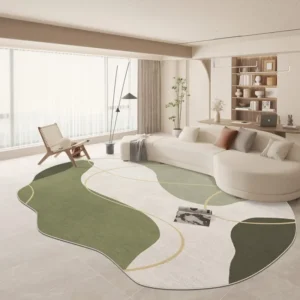 Large Area Green Rugs for Bedroom Nordic Living Room Decoration Shaped Carpet Irregular Plush Lounge Rug Home Thick Washable Mat
Rated 5.00 out of 5$54.94 – $346.41Price range: $54.94 through $346.41
Large Area Green Rugs for Bedroom Nordic Living Room Decoration Shaped Carpet Irregular Plush Lounge Rug Home Thick Washable Mat
Rated 5.00 out of 5$54.94 – $346.41Price range: $54.94 through $346.41 -
 Nordic Style Rugs for Bedroom Morandi Living Room Decoration Carpet Large Area Geometry Lounge Rug Home Cloakroom Non-slip Mat
Rated 5.00 out of 5$39.46 – $597.66Price range: $39.46 through $597.66
Nordic Style Rugs for Bedroom Morandi Living Room Decoration Carpet Large Area Geometry Lounge Rug Home Cloakroom Non-slip Mat
Rated 5.00 out of 5$39.46 – $597.66Price range: $39.46 through $597.66 -
 Irregular Shapes Living Room Decoration Carpet Modern Style Rugs for Bedroom Home Thicken Plush Rug Fluffy Soft Lounge Floor Mat
Rated 4.83 out of 5$55.84 – $347.37Price range: $55.84 through $347.37
Irregular Shapes Living Room Decoration Carpet Modern Style Rugs for Bedroom Home Thicken Plush Rug Fluffy Soft Lounge Floor Mat
Rated 4.83 out of 5$55.84 – $347.37Price range: $55.84 through $347.37

